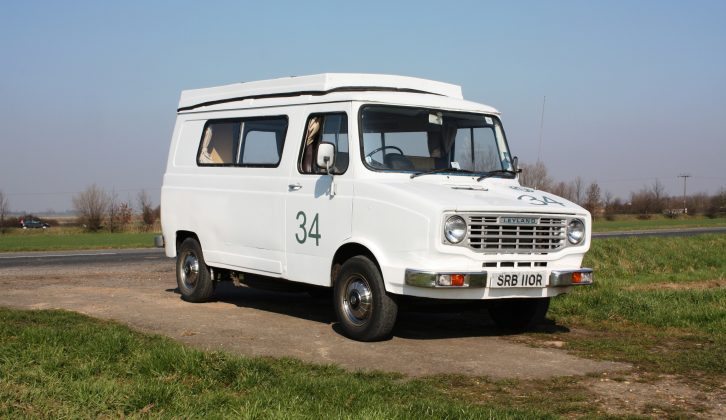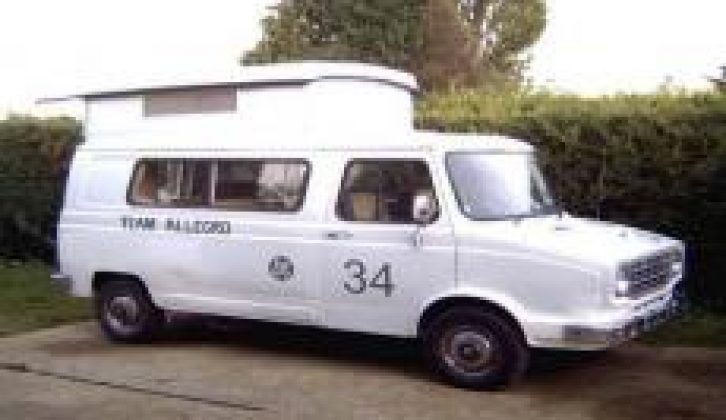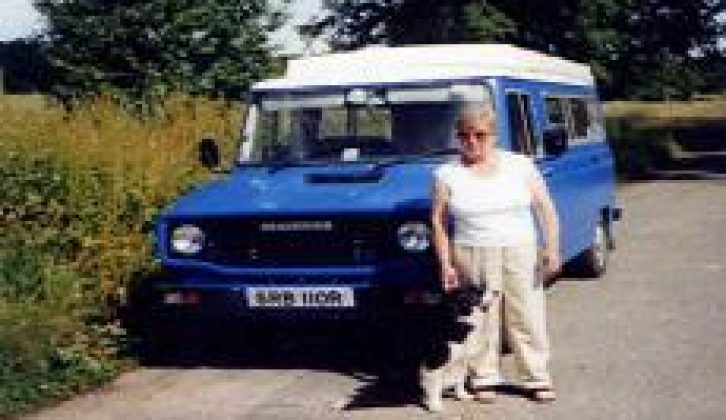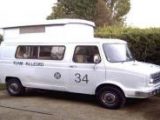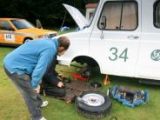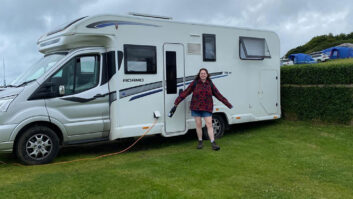In the final instalment of our Project Peanuts series, Gentleman Jack speaks to some of the plucky motorhome’s previous owners
We know that many readers of Practical Motorhome want to make the motorcaravanning life a reality rather than merely dreaming about it. Therefore, we decided with this series that we would show you how it can be achieved for far less money than others quote.
Fed up with ‘vans costing over £20,000 being described as ‘starter ‘vans’, we decided to support mum Kate and her 16-year-old son Kyle in buying and improving a motorcaravan for less than £2000. Our original idea was [tl:gallery index=1 size=288×173]to spend less than a grand on a vehicle and another grand running it for at least a year. Over the past 15 months we’ve accounted for every penny spent, including VED (tax disc) and insurance. We’ve fixed dodgy mechanicals, titivated the interior, made sure the habitation equipment is safe and even managed a bit of a make-over to the bodywork. The total spend (excluding purchase) was well under £1000 and this is for two full seasons’ use as a campervan and (hopefully) two years’ use as a daily driver. If Kate and Kyle decide to sell, they would get the purchase price back tomorrow and would probably make a healthy profit, too.
As I explained at the start of the project, there are really only three basic ways to start motorcaravanning without much dosh:
1. Manage an evolving conversion
Buy a panel van and a mattress and think of it as a ‘tin tent’. Use a camp stove outside the ‘van. Buy or have built the interior interior furniture as funds permit. Buy any fittings from eBay or from dismantlers.
2. Enjoy a harvest festival
Find a caravan dismantler and harvest any useful spare parts from a ‘total-loss’ caravan, such as windows, furniture, fittings, soft furnishings etc. Then sell the aluminium cladding and rolling chassis to a potential trailer builder. This will help finance the purchase of a panel van to transplant it all into.
3. Buy a good fixer-upper
This will be a converted van (either commercially or someone else’s home brew) that is likely to be ancient, untidy and/or requiring some DIY work. At our price-point it’s bound to need some TLC but it should be usable ‘as is’. It is the only option which offers motorcaravanning out of the box, which is why we chose to go down this route.
[tl:gallery index=2 size=230×138]After only a short search the crew homed in on the Sherpa. It had first been spotted as a photo ad in a magazine, and three things set the pulses racing: first, the vendor’s candid and amusing description; second, it was only half an hour away; and third, the price.
[tl:gallery index=3 size=173×242]After a brief road test it was found to be exactly as described, an offer was made and a deal was struck. SRB 110R, or Number 34, changed hands for £825.
Peanuts’ history
The ‘log sheet’ indicated that, over the previous 34 years, Peanuts had served 12 owners, making us the 13th. We all hoped this wasn’t an ill omen. It is not generally known but the much-maligned DVLA will help present owners identify previous owners of cherished vehicles, providing they are satisfied as to the motives. Apply in writing; from memory the fee was around £5-£10. For this we received photocopies of all the documentation submitted to the DVLA by each owner. This also gave me their addresses during the period of ownership.
[tl:gallery index=4 size=288×179]I wrote a letter to all the previous owners, explaining what our starter ‘van project was about, and enclosed a photograph of Peanuts for them to keep. The only exception to this was Peter who had sold it to us. He had already provided as much historic background as he could. It was hoped that at least one or two previous owners would reply.
[tl:gallery index=5 size=230×138]We were thrilled to receive seven responses. Some from owners themselves, one from younger surviving relatives and one from someone unrelated but who had bought the property from the former owner 20 years ago. She turned detective after remembering that she was at school with a distant relative of the previous occupier. They were traced and, although now in poor health, were thrilled [tl:gallery index=6 size=230×138]to hear that their ‘Betty’, as she was then named, was still going strong (well, still going, anyway!). The two photos above show the Sherpa on the 2010 End2End Land’s End to John O’Groats rally event and an unscheduled pit stop. To the right is former owner Mrs Harding with Cathy the Collie (the photo was taken by her husband Frank).
Patterns of ownership
Years of research have shown me that there are a couple of identifiable ownership patterns for motorcaravans. Of course, a sizeable minority, of around 35 per cent, don’t fit into any particular pattern. Also, many in the lower price bracket are sold to groups of friends all clubbing together (frequently overseas visitors to the UK and Europe), used for a particular trip averaging 4 months, and then sold on immediately afterwards.
1. Churners
These are motorcaravans which change hands every two to three years. The Bancroft Tribe, for example, aim to buy at three years of age and sell at six, and so on.
2. Investors
These ‘vans have early owners who buy for the long-term. The longest ownership will be by the first purchaser who is likely to enjoy it for between five to 10 years. The second owner is likely to keep it for three to five years, after which the third owner will have it for between two to four years. Finally, as it passes its 16th birthday, the average ownership will be just 18 months until it reaches that great campsite in the sky.
Speaking of scrapyards and vehicle dismantlers, Peanuts was almost scrapped twice during her lifetime. First she was vandalised and the insurance company wanted to declare her a total loss, or write-off as it was then called. Second, after some less-than-successful renovation and a fairly spectacular MoT failure, she was weighed-in at Bells Auto Spares. Here a member of staff called Gordon Heslop thought she was too good to scrap, so spent his spare time resuscitating her and eventually got her back on the road. Fortunately for us he persevered against considerable odds. Thanks Gordon, if it wasn’t for your determination…
Peanuts’ past custodians and their length of ownership
No.1 7 years, 8 months
No.2 2 years, 6 months
No.3 2 years
No.4 3 years
No.5 7 months
No.6 20 days
No.7 1 year, 6 months
No.8 5 months
No.9 1 year, 5 months
No.10 1 year
No.11 1 year, 11 months
No.12 1 year, 5 months
No.13 1 year, 6 months – so far!
Behind the raw data
Everybody who got in touch loved owning the old Sherpa. She has been to the far corners of the United Kingdom and even ventured abroad to France, Germany, Belgium and Spain. She was the first motorcaravan for five of the owners, all of whom enjoyed the experience so much they continued motorcaravanning. In some cases this love of touring has been continued by the next generation, in one case by both their daughters and now by grandchildren who have their own ‘van.
We know that at least four folk learned to drive in her. Plus, I guess many nippers have steered her sitting on Dad’s knee whilst traversing empty campsites and farmers’ fields in the days before `elf and safety’ was even thought of!
[tl:gallery index=7 size=288×173]Currently she is being used by owner Kate and teenage son Kyle (see right and below) to support trips away boarding, surfing, climbing and of course for holidays and days out. All of this is in addition to duties as general load lugger and auxiliary [tl:gallery index=8 size=230×138]accommodation at home.
Fond memories of Peanuts
Finally, here are some comments from some of Peanuts’ former owners:
“It never let us down, was great fun and simple to use.”
“You never forget your first campervan – happy days.”
“We recognised her immediately and felt that we could just climb aboard and be off somewhere.”
“We were so proud of her. I gave guided tours to neighbours and on the Sunday after we collected her we all had our tea in her while parked in our back garden.”
“Our children were small then and the night before we went away they usually couldn’t sleep for excitement. Everything was an adventure back then, even though money was tight and we couldn’t afford to go far.”
No-one commented on the dreadfully heavy (non-assisted) steering, the tendency for the Leyland bodywork of this era to dissolve in a light shower of rain, the lacklustre performance, vibrating propshaft and the diff which whines like an army truck!
The psychologist who first said, “The most selective mechanism in the world is the human memory” was bang on the money.
Spec check
1977 Auto-Sleeper LS 63 on Leyland Sherpa 215
Original supplier
Panel van finished in Glacier White supplied by Kenning Truck Centre, converted by Auto-Sleeper, first registered and sold by Don Amott Caravans, Derby.
First registered 01/05/1977
Price when new £3938 (equivalent to £22,329 in today’s money)
Mechanicals 1.8-litre four-cylinder BMC ‘B’-series petrol engine driving the rear wheels via a four-speed manual gearbox with after-fit Laycock de Normanville overdrive operating on all gears.
Conversion Solid-sided elevating roof. Two adult single berths, one child canvas bunk berth.
Length 4.8m (15’8″)
MGW 2180kg
Fuel consumption 22mpg
Cruising speed 50mph (60mph if you have ear plugs!)
Want to know more?
The Project Peanuts instalments are all available on our website – click on the following links:
- Part 1: buying a van – your options
- Part 2: more buying tips and insurance
- Part 3: safety check, towbar and rear step
- Part 4: essential roof repairs
- Part 5: making safe old DIY horrors
- Part 6: refitting the hob, fridge and some wiring
- Part 7: general improvements to the interior
- Part 8: making new door cards
- Part 9: ‘wiring’ for 230V and winter prep
- Part 10: repairing faulty indicators
- Part 11: touching-up the cabinetwork
- Part 12: renewing the floor covering and fixing wipers
- Part 13: cosmetic fixes to the bodywork
In addition, Gentleman Jack has prepared an information sheet giving full details of the specialist suppliers and insurance company used in this series. To receive it contact him via askjack@practicalmotorhome.com and he’ll get back to you. Further, he’ll use his best endeavours to answer any queries that people undertaking similar projects need help with.
Jack already knows of other new owners of sub-£5000 starter ‘vans, all of whom have been inspired by Peanuts. Do send Jack any photos of similar projects and we’ll do our best to publish them.
[tl:gallery index=9 size=120×138]For now, just live the dream. After, that’s what Kate and Kyle are doing.
